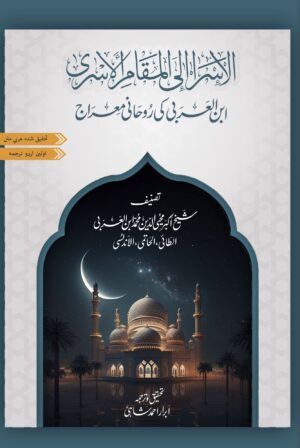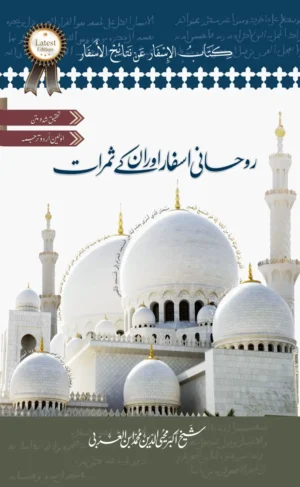Reviewed and corrected 2nd edition
Author: Shaykh al-Akbar Muhyiddin Ibn al-Arabi
Editor: Abrar Ahmed Shahī
Pages: 250
ISBN: 9789699305122
Dimensions: 255 × 165 mm
Edition: 2nd. May 2017
Shaykh al-Akbar
Ibn al-Arabi
Ibn al-Arabi Foundation
Critical Arabic Edition
PDF – Book
Ibn ‘Arabî’s work “Ruh al-Quds fî munâsahat al-nafs” is widely regarded as a masterpiece. In its introduction, Ibn ‘Arabî launches a strong critique of contemporary Sufism. He condemns the superficial adoption of Sufi attire, criticizes the prevailing khânaqâh system, and emphasizes his disapproval of the Sufi practice of samâ’ or spiritual audition. Notably, this self-critical approach among “Sufi” authors was not initiated by Ibn ‘Arabî, as he points out that al-Qushayrî also sternly rebukes such deviations in his “Risâla.”
The distinct contribution of Ibn ‘Arabî’s criticism lies in his exploration of the positive aspects within his reproachful perspective. Notably, he addresses the concept of companionship within Sufism. He questions the nature of contemporary companionships, suggesting that they are often driven by flattery. Paradoxically, in an era he views as corrupt, Ibn ‘Arabî himself manages to establish more than fifty meaningful companionships. He hints at recording some of these relationships while remaining reticent about most, thereby hinting at a hidden depth of experience.
Structurally, the work can be divided into three roughly equal sections through the biographical narratives. However, a more profound thematic division aligns with the traditional Sufi journey. The first section, spanning pages 31 to 88, aligns with the concept of mi’râj or spiritual ascent. The second section, from pages 139 to 176, corresponds to ruju’ or the return, marking the Sufi’s reintegration into worldly life. Lastly, the divine sphere (mushâhada) is explored in the range of pages 88 to 139. This is where the numerous mi’râjs and ruju’s are situated, representing the sacred space of direct spiritual experiences.
In essence, Ibn ‘Arabî’s “Ruh al-Quds fî munâsahat al-nafs” stands as a remarkable work that not only critiques contemporary Sufism but also delves into the intricacies of companionship and the multifaceted Sufi journey, all the while drawing from a rich tradition of self-criticism within the genre.
Throughout this epistle Ibn al-Arabî addresses his Tunisian friend ‘Abd al-‘Aziz al-Mahdawî, at one of these instances he Says:
You have gained, my brother – may God make me and you of those who have gained in this age of yours – in a manner such that I don’t expect to see them (these spiritual gains, fawz) from any other than you. Of them (the fawzs) is your acknowledgement of the rank of knowledge and those possessing it (al-‘ilm wa ahli-hi), the lack of aspiration, on your behalf, to miracles and states. Of them, is your submission to God, your humility and compliance to Him in respect of who you find, regardless of whether he is one whom people notice or nobody cares about. Also, you do not consider your worldly position that is, peoples’ praising of you, kissing your hand or the coming of Sultans to your door. This is the height of just treatment, may God keep you firm. Of them is your saying, when you don’t know something, “I don’t know” and when you do know, “I would like to hear it from other than me”. By God, you have gained, my friend, qualities which cause heads to soar from necks, a station (maqâm) which is unaffected by the states (al-ahwâl), whose brilliance is not exceeded by supererogatory works. Then your search, which I haven’t seen from other than you, concerning knowledge of humankind and of time, and your belief that it is of divine necessity…
The “Ruh al-Quds fi munashat al-Nafs,” has undergone thorough validation through three historical manuscripts. Among them, the most noteworthy is University A79, transmitted by al-Ḥabashī, dated 600H, and encompassing at least nine instances of samāʿ during IA’s lifetime. This newly presented edition assures authenticity and adherence to the author’s original intent. The critical Arabic edition is based on meticulous examination of five manuscripts. This process ensures a faithful representation of the work, preserving its purity while drawing from multiple sources to enhance accuracy and reliability.
Uni A79 stands as the most superior manuscript of the “Ruh al-Quds.” Penned by Abdullah Badar al-Habashī and dated 600H, it contains numerous instances of samāʿ, spanning from 600H in Mecca to 634H in Damascus (refer to pages 102a-103b), all verified by Ibn al-Arabi. The manuscript presents a lucid text, with the names of Maghribi masters highlighted in larger fonts, facilitating navigation within the content.
On the title page 1a: “Written by the humble servant of Allah, Muhammad ibn Ali ibn al-Arabi al-Ta’i al-Hatimi al-Andalusi, from Mecca—may Allah guard it—during the year six hundred, addressed to Abdul Aziz ibn Abi Bakr al-Qurashi al-Mahdawi, residing in Tunis, situated in the Maghrib lands. May Allah be pleased with both of them and grant them forgiveness, along with all Muslims.”
Narrated by Abdullah al-Mas’ud Badar ibn Abdullah al-Habashī, a freedman of Abu al-Ghanā’im ibn Abi al-Fatūh al-Harani, and may Allah pardon his sins.
“Read by all from its author, Ayoub ibn Badr ibn Mansour al-Muqri al-Qahiri.” “Heard and selected from it what was accessible, Ibrahim ibn al-Hussein al-Erbilī—may Allah pardon him.”
This record affirms the significance and authenticity of Uni A79 in preserving the essence of “Ruh al-Quds.”
The manuscript titled “Shehit Ali 1341” was transcribed by Abū Riḍā bin Sayyid ʿAlī b. Muḥammad al-Jawnī in the month of Rabi ul Awwal 724H. The scribe, Abū Riḍā Muṭahhar b. Sayyid ʿAlī b. Muḥammad al-Jawnī, copied the work in Damascus. The copy is believed to be from an original text as per OY, although this claim remains unverified. The absence of accompanying notes makes it challenging to establish precise details about the manuscript’s origins, but the collection contains comparable notes on other works (like 75b, 120a, 132a), which provide hints regarding the date, place of writing, and the scribe’s name. Nevertheless, doubts arise regarding the originality claim due to discrepancies such as the misspelled title. Despite these uncertainties, the manuscript is acknowledged as a faithful representation of the referenced work.
The manuscript titled “R. al-Azīziyya” is housed in the Hudayi Library under code 517 in the Haci Selim Collection in Istanbul. It spans from page 92b to 133a and occupies the 9th position out of 11 orders in the book. Written by IA, the manuscript holds a verified A status for its work “R. Rūḥ al-quds fī munāṣaḥat al-nafs” (via rg_01: 639 [65]). Dated to the year 999, the place of writing is unspecified. The scribe behind this manuscript is Azīz Maḥmūd Hudayī. The text is distinctive due to its unique variant title, with a particularly skilled presentation, including red-highlighted names in the margins. A note appended at the end indicates that the manuscript was copied on the 15th of Rajab in 999H. This work, attributed to Azīz Maḥmūd Hudayī, stands out for its careful execution, featuring individuals’ names in red within the margins, and is historically significant due to its transcription date in 999H.
This compilation, known as “Fakhr al-din al-Khurasani’s copy,” encompasses over 60 writings of Shaykh al-Akbar Fakhr al-Din Khurasani, meticulously transcribed in the year 814. The scribe, an ardent admirer of Fakhr al-Din Khurasani, undertook this task in Zubaid, Yemen. This comprehensive assortment holds remarkable significance, as it features numerous works by Ibn al-Arabi. While some pieces include annotations suggesting their transcription from originals, the overall compilation is deemed valuable. The manuscripts within this collection not only reflect the admirer’s dedication to Fakhr al-Din Khurasani but also offer a noteworthy selection of Ibn al-Arabi’s writings, contributing to the preservation of his legacy.
Catalogued within the Yusuf Aga Library under code 4860, this manuscript bears the title “Rūḥ al-quds.” The place of origin and date remain uncertain, potentially preceding 700H. The manuscript’s historical value is noteworthy, as it is housed within Yusuf Aga’s esteemed collection in Konya. However, its reliability is questionable; it has been employed primarily for word confirmation due to its inconsistencies. Some passages exhibit subpar quality, often diverging from content found in other manuscripts. The manuscript’s origin from SQ’s library further complicates its history, suggesting it was acquired prior to 700H. The text, found on page 50, marks the commencement of Rūḥ al-quds. The manuscript’s conclusion at page 202 is followed by a collection of poems, previously assigned reference number 5595. Inaccuracies in page numbering persist throughout the Yusuf Aga collection.
Hailing from King Saud University, this manuscript’s scribe remains anonymous. Copied in Bayat al-Maqdas and finalized during the month of Sh’ban al-muazzam 743H, the manuscript’s general condition is satisfactory. While it doesn’t attain high levels of accuracy and reliability, it has been integrated into our edition.



